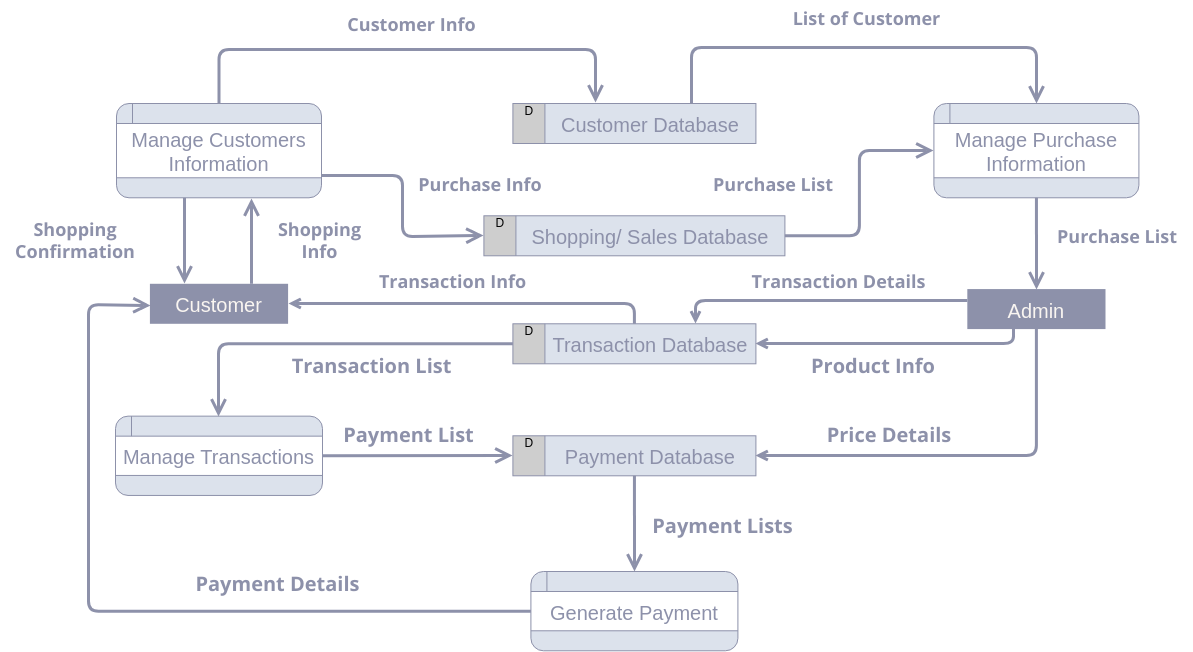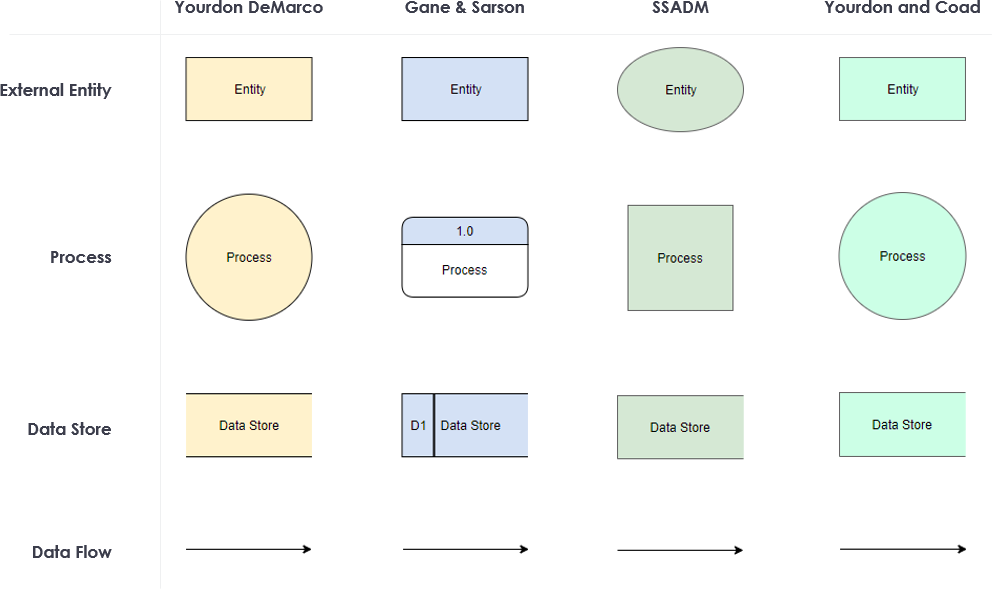Introduction
In the rapidly evolving landscape of retail, managing customer information, processing purchases, and handling transactions efficiently are critical to maintaining a competitive edge. As businesses grow, the complexity of these operations increases, often leading to fragmented systems and inefficient processes. This article explores the use of Data Flow Diagrams (DFDs) to analyze and redesign a retail company’s information system, aiming to integrate customer data, streamline purchase processing, and enhance transaction management. By adopting a structured system analysis approach, the company seeks to improve operational efficiency, reduce errors, and ultimately enhance customer satisfaction. The relevance of this approach in today’s agile development environment is also examined, highlighting how iterative development and stakeholder involvement can drive successful system implementation.
Problem Statement
A retail company aims to enhance its customer management and transaction processing systems to improve efficiency and customer satisfaction. The current system lacks integration between customer information, purchase data, and transaction management, leading to delays and errors in processing orders and payments. The company seeks to develop a unified system that streamlines customer information management, purchase tracking, and transaction processing, ensuring seamless data flow and improved operational efficiency.
Case Study for Conducting Structured System Analysis
Background
The retail company has experienced significant growth in recent years, leading to an increased volume of customer transactions. However, the existing system’s fragmented nature has resulted in inefficiencies, such as duplicate data entry, delayed order processing, and inaccuracies in transaction records. To address these challenges, the company plans to implement a structured system analysis to redesign its information systems, focusing on integrating customer data, purchase information, and transaction management.
Objectives
- Integrate Customer Data: Centralize customer information to ensure consistency and accuracy across all departments.
- Streamline Purchase Processing: Improve the efficiency of purchase tracking and order management.
- Enhance Transaction Management: Ensure accurate and timely processing of transactions, including payment generation and tracking.
- Improve Data Flow: Facilitate seamless data flow between different system components to reduce errors and delays.
Structured System Analysis Approach
-
Requirement Gathering:
- Conduct interviews and surveys with stakeholders, including customers, admin staff, and management, to understand their needs and pain points.
- Analyze existing processes and identify bottlenecks and inefficiencies.
-
Data Flow Diagram (DFD) Development:
- Create DFDs to visualize the current system’s data flow and identify areas for improvement.
- Use the DFD to map out the proposed system’s data flow, ensuring integration between customer information, purchase data, and transaction management.
-
System Design:
- Design a unified database structure to centralize customer and transaction data.
- Develop modules for managing customer information, processing purchases, and handling transactions.
- Implement data validation and error-checking mechanisms to ensure data accuracy.
-
Implementation:
- Develop the system using agile methodologies to allow for iterative testing and feedback.
- Integrate the new system with existing infrastructure, ensuring minimal disruption to ongoing operations.
-
Testing and Validation:
- Conduct thorough testing to ensure the system meets the specified requirements.
- Validate the system with real-world scenarios to identify and address any issues.
-
Deployment and Training:
- Deploy the new system across all relevant departments.
- Provide training to staff to ensure they are proficient in using the new system.
Relevance to Agile Approach
The structured system analysis approach outlined above aligns with the Agile methodology in several ways:
-
Iterative Development: Agile emphasizes iterative development, allowing for continuous feedback and adjustments. The proposed system will be developed in iterations, with regular testing and validation to ensure it meets user needs.
-
Stakeholder Involvement: Agile encourages active stakeholder involvement throughout the development process. By conducting interviews and surveys, the company ensures that stakeholder needs are understood and addressed.
-
Flexibility: Agile methodologies allow for flexibility in responding to changes in requirements or priorities. The iterative nature of the development process enables the company to adapt to changing needs and feedback.
-
Collaboration: Agile promotes collaboration between development teams and stakeholders. The structured system analysis approach involves collaboration between different departments to ensure a unified and integrated system.
DFD Example
The Data Flow Diagram (DFD) below represents a system designed to manage customer information, purchases, and transactions within a retail environment. It illustrates how data flows between different processes, data stores, and external entities. Here’s a detailed explanation of each component and their interactions:

External Entities
-
Customer:
- Provides Customer Info to the “Manage Customers Information” process.
- Receives Shopping Confirmation from the “Manage Customers Information” process after shopping activities.
- Provides Shopping Info to the “Manage Customers Information” process.
- Provides Transaction List to the “Manage Transactions” process.
- Provides Payment Details to the “Generate Payment” process.
-
Admin:
- Provides Purchase List to the “Manage Purchase Information” process.
- Provides Transaction Details to the “Manage Transactions” process.
- Provides Product Info and Price Details to the “Manage Purchase Information” process.
Processes
-
Manage Customers Information:
- Receives Customer Info from the Customer and stores it in the Customer Database.
- Provides Shopping Confirmation to the Customer after processing shopping activities.
- Receives Shopping Info from the Customer and sends Purchase Info to the Shopping/Sales Database.
-
Manage Purchase Information:
- Receives Purchase List from Admin and interacts with the Shopping/Sales Database to manage purchase records.
- Receives Product Info and Price Details from Admin to update the Shopping/Sales Database.
- Sends Transaction Info to the Transaction Database.
-
Manage Transactions:
- Receives Transaction List from the Customer and Transaction Details from Admin.
- Interacts with the Transaction Database to manage transaction records.
- Sends Payment List to the Payment Database.
-
Generate Payment:
- Receives Payment Details from the Customer and interacts with the Payment Database to generate payment records.
- Receives Payment Lists from the Payment Database to process payments.
Data Stores
-
Customer Database:
- Stores customer-related information received from the “Manage Customers Information” process.
- Provides List of Customer to the “Manage Purchase Information” process.
-
Shopping/Sales Database:
- Stores shopping and sales data received from the “Manage Customers Information” and “Manage Purchase Information” processes.
- Provides Purchase Info to the “Manage Purchase Information” process.
-
Transaction Database:
- Stores transaction data received from the “Manage Transactions” process.
- Provides Transaction Info to the “Manage Transactions” process.
-
Payment Database:
- Stores payment data received from the “Generate Payment” process.
- Provides Payment Lists to the “Generate Payment” process.
Data Flows
- Customer Info: Flows from the Customer to the “Manage Customers Information” process and then to the Customer Database.
- Shopping Confirmation: Flows from the “Manage Customers Information” process to the Customer.
- Shopping Info: Flows from the Customer to the “Manage Customers Information” process and then to the Shopping/Sales Database.
- Purchase Info: Flows from the “Manage Customers Information” process to the Shopping/Sales Database.
- Purchase List: Flows from Admin to the “Manage Purchase Information” process.
- Transaction List: Flows from the Customer to the “Manage Transactions” process.
- Transaction Details: Flows from Admin to the “Manage Transactions” process.
- Payment Details: Flows from the Customer to the “Generate Payment” process.
- Payment List: Flows from the “Manage Transactions” process to the Payment Database.
- Product Info and Price Details: Flow from Admin to the “Manage Purchase Information” process
DFD Element Notation

Interpretation
This DFD effectively illustrates the interactions between customers, admin, and the system’s databases. It highlights how customer information is managed, purchases are processed, transactions are recorded, and payments are generated. The diagram emphasizes the importance of data integration and flow between different system components to ensure efficient and accurate operations. This structured approach to system analysis helps in identifying potential bottlenecks and improving overall system performance.
Conclusion
The implementation of a structured system analysis approach, as illustrated through the Data Flow Diagram, offers a comprehensive solution to the challenges faced by retail companies in managing customer and transaction data. By centralizing customer information, streamlining purchase processes, and ensuring accurate transaction management, the proposed system aims to enhance operational efficiency and customer satisfaction.
Moreover, the alignment of this approach with agile methodologies underscores its relevance in modern software development, emphasizing iterative development, stakeholder involvement, and flexibility. As businesses continue to evolve, adopting such integrated and agile systems will be crucial in maintaining competitiveness and meeting the ever-changing demands of the market.
DFD References
-
Visual Paradigm Data Flow Diagrams – Stack Overflow
- Discusses the availability of Data Flow Diagrams in different editions of Visual Paradigm, including the need for the Modeler Edition or higher to create DFDs.
- Read more on Stack Overflow
-
Online Data Flow Diagram Maker
- An online tool for creating Data Flow Diagrams quickly and efficiently, with features for sharing diagrams in various formats.
- Explore the Online DFD Maker
-
A Step-by-Step Guide to Creating Data Flow Diagrams with Visual Paradigm
- Provides a detailed guide on creating DFDs using Visual Paradigm, including drag-and-drop functionality for external entities and processes.
- Access the Step-by-Step Guide
-
Data Flow Diagram Tool – Visual Paradigm
- Highlights the features of Visual Paradigm’s DFD tool, including the ability to decompose processes and maintain model integrity across different levels.
- Learn about the DFD Tool
-
What is Data Flow Diagram?
- Explains the structure and purpose of DFDs, emphasizing their role in visualizing data flow within a system.
- Understand Data Flow Diagrams
-
Data flow diagram in Visual Paradigm
- Offers a chapter on creating DFDs with Visual Paradigm, including supported notations and process decomposition techniques.
- Read the Data Flow Diagram Chapter
-
How to Draw Data Flow Diagram (DFD)?
- Provides instructions on drawing DFDs, including how to decompose processes and manage data flows between different levels.
- Learn How to Draw DFDs 7
-
Mastering Data Flow Diagrams with Visual Paradigm: A Step-by-Step Guide
- A comprehensive guide on mastering DFDs using Visual Paradigm, with practical examples and templates.
- Access the Mastering DFD Guide
-
Data Flow Diagram Templates
- Offers free online DFD templates and examples to help users create professional diagrams.
- Explore DFD Templates
-
How to Create Data Flow Diagram (DFD)?
- A tutorial on creating DFDs, including steps for selecting templates and adding details to diagrams.
- Follow the DFD Creation Tutorial
These references provide a solid foundation for understanding and creating Data Flow Diagrams using Visual Paradigm, with resources ranging from basic guides to advanced tutorials.

